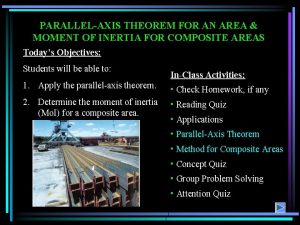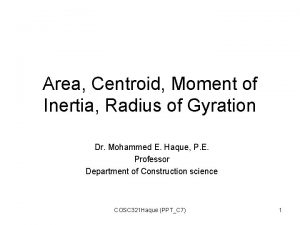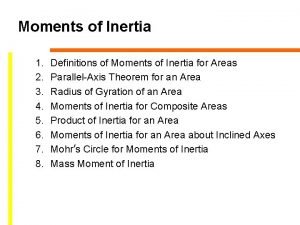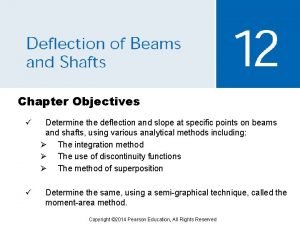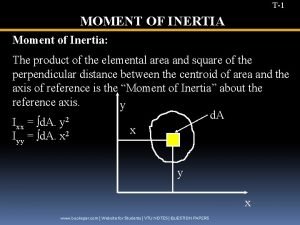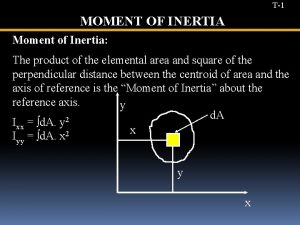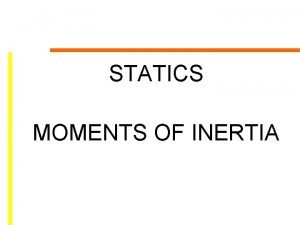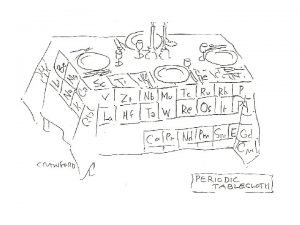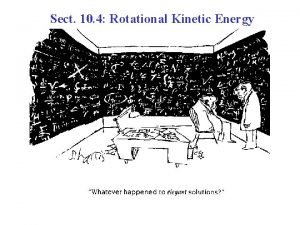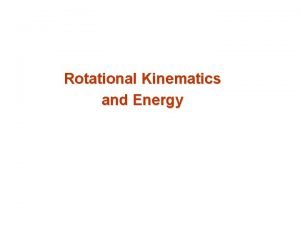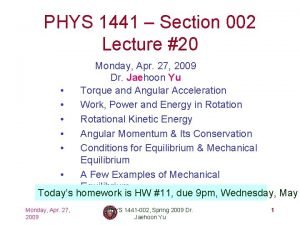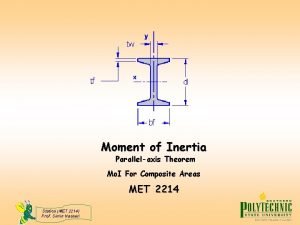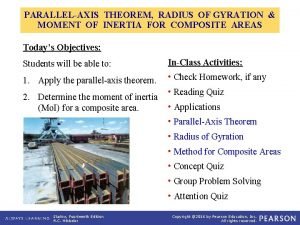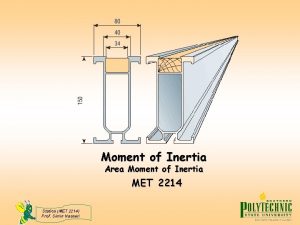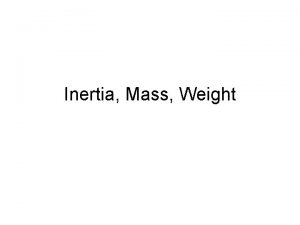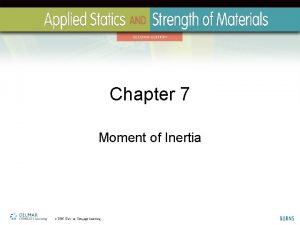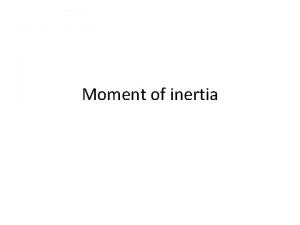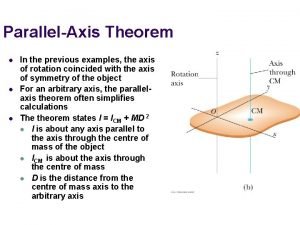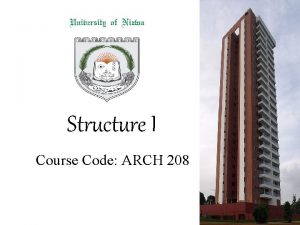PARALLELAXIS THEOREM FOR AN AREA MOMENT OF INERTIA

















- Slides: 17

PARALLEL-AXIS THEOREM FOR AN AREA & MOMENT OF INERTIA FOR COMPOSITE AREAS Today’s Objectives: Students will be able to: In-Class Activities: 1. Apply the parallel-axis theorem. • Check Homework, if any 2. Determine the moment of inertia (Mo. I) for a composite area. • Reading Quiz • Applications • Parallel-Axis Theorem • Method for Composite Areas • Concept Quiz • Group Problem Solving • Attention Quiz

READING QUIZ 1. The parallel-axis theorem for an area is applied between A) an axis passing through its centroid any corresponding parallel axis. B) any two parallel axis. C) two horizontal axes only. D) two vertical axes only. 2. The moment of inertia of a composite area equals the ____ of the Mo. I of all of its parts. A) vector sum B) algebraic sum (addition or subtraction) C) addition D) product

APPLICATIONS Cross-sectional areas of structural members are usually made of simple shapes or combination of simple shapes. Is there a simpler method for determining the Mo. I of such cross-sectional areas as compared to the integration method? If yes, can you describe the method?

APPLICATIONS (continued) This is another example of a structural member with a composite cross-area. Design calculations typically require use of the Mo. I for these cross-sectional areas. Can you describe a simple method to calculate Mo. I?

PARALLEL-AXIS THEOREM FOR AN AREA (Section 10. 2) This theorem relates the moment of inertia (Mo. I) of an area about an axis passing through the area’s centroid to the Mo. I of the area about a corresponding parallel axis. This theorem has many practical applications, especially when working with composite areas. Consider an area with centroid C. The x' and y' axes pass through C. The Mo. I about the x-axis, which is parallel to, and distance dy from the x ' axis, is found by using the parallel-axis theorem.

PARALLEL-AXIS THEOREM (continued) IX = A y 2 d. A = A (y' + dy)2 d. A = A y' 2 d. A + 2 dy A y' d. A + dy 2 A d. A Using the definition of the centroid: y = y' + dy y' = ( A y' d. A) / ( A d. A). Now since C is at the origin of the x' – y' axes, y' = 0 , and hence A y' d. A = 0. Thus IX = IX' + A dy 2 Similarly, IY = IY' + A d. X 2 JO = J C + Ad 2 and

MOMENT OF INERTIA FOR A COMPOSITE AREA (Section 10. 5) A composite area is made by adding or subtracting a series of “simple” shaped areas like rectangles, triangles, and circles. For example, the area on the left can be made from a rectangle minus a triangle and circle. The Mo. I of these “simpler” shaped areas about their centroidal axes are found in most engineering handbooks as well as the inside back cover of the textbook. Using these data and the parallel-axis theorem, the Mo. I for a composite area can easily be calculated.

STEPS FOR ANALYSIS 1. Divide the given area into its simpler shaped parts. 2. Locate the centroid of each part and indicate the perpendicular distance from each centroid to the desired reference axis. 3. Determine the Mo. I of each “simpler” shaped part about the desired reference axis using the parallel-axis theorem ( IX = IX’ + A ( dy )2 ). 4. The Mo. I of the entire area about the reference axis is determined by performing an algebraic summation of the individual Mo. Is obtained in Step 3. (Please note that Mo. I of a hole is subtracted).

EXAMPLE Given: The beam’s cross-sectional area. Find: The moment of inertia of the area about the y-axis and the radius of gyration ky. Plan: Follow the steps for analysis. [1] [2] [3] Solution 1. The cross-sectional area can be divided into three rectangles ( [1], [2], [3] ) as shown. 2. The centroids of these three rectangles are in their center. The distances from these centers to the y-axis are 0 mm, 87. 5 mm, and 87. 5 mm, respectively.

EXAMPLE (continued) 3. From the inside back cover of the book, the Mo. I of a rectangle about its centroidal axis is (1/12) b h 3. Iy[1] = (1/12) (25 mm) (300 mm)3 = 56. 25 (106) mm 4 [1] [2] [3] Using the parallel-axis theorem, IY[2] = IY[3] = IY’ + A (d. X)2 = (1/12) (100) (25)3 + (25) (100) ( 87. 5 )2 = 19. 27 (106) mm 4

EXAMPLE (continued) 4. Iy = = Iy 1 + Iy 2 + Iy 3 94. 8 ( 106) mm 4 ky = ( Iy / A) A 300 (25) + 25 (100) = 12, 500 mm 2 = ky = ( 94. 79) (106) / (12500) = 87. 1 mm

CONCEPT QUIZ 1. For the area A, we know the centroid’s (C) location, area, distances between the four parallel axes, and the Mo. I about axis 1. We can determine the Mo. I about axis 2 by applying the parallel axis theorem ___. A) directly between the axes 1 and 2. B) between axes 1 and 3 and then between the axes 3 and 2. C) between axes 1 and 4 and then axes 4 and 2. D) None of the above. Axis A d 3 d 2 d 1 C • 4 3 2 1

CONCEPT QUIZ (continued) A d 3 d 2 d 1 2. C • Axis 4 3 2 1 For the same case, consider the Mo. I about each of the four axes. About which axis will the Mo. I be the smallest number? A) Axis 1 B) Axis 2 C) Axis 3 D) Axis 4 E) Can not tell.

GROUP PROBLEM SOLVING Given: The shaded area as shown in the figure. Find: The moment of inertia for the area about the x-axis and the radius of gyration k. X. Plan: Follow the steps for analysis. (a) (b) (c) Solution 1. The given area can be obtained by subtracting both the circle (b) and triangle (c) from the rectangle (a). 2. Information about the centroids of the simple shapes can be obtained from the inside back cover of the book. The perpendicular distances of the centroids from the x-axis are: da = 5 in , db = 4 in, and dc = 8 in.

GROUP PROBLEM SOLVING (continued) 3. IXa = (1/12) 6 (10)3 + 6 (10)(5)2 = 2000 in 4 IXb = (1/4) (2)4 + (2)2 (4)2 = 213. 6 in 4 IXc (a) (b) (c) IX = IXa (½) (3) (6) (8)2 = 594 in 4 – k. X = ( IX / A ) A 10 ( 6 ) – = k. X = = (1 /36) (3) (6)3 + IXb – IXc = 1190 in 4 (2)2 – (½) (3) (6) = (1192 / 38. 43) = 5. 57 in. 38. 43 in 2

A=10 cm 2 ATTENTION QUIZ 1. For the given area, the moment of inertia about axis 1 is 200 cm 4. What is the Mo. I about axis 3 (the centroidal axis)? A) 90 cm 4 B) 110 cm 4 C) 60 cm 4 D) 40 cm 4 2. The moment of inertia of the rectangle about the x-axis equals A) 8 cm 4. C) 24 cm 4. B) 56 cm. 4 D) 26 cm 4. d 2 C C • 3 2 • d 1 1 d 1 = d 2 = 2 cm 3 cm 2 cm x

 The parallel-axis theorem for an area is applied between
The parallel-axis theorem for an area is applied between Parallel axis theorem product of inertia
Parallel axis theorem product of inertia Area moment of inertia
Area moment of inertia Ix=bh^3/12
Ix=bh^3/12 Units of product of inertia are
Units of product of inertia are Elastic curve of a beam
Elastic curve of a beam Singularity functions
Singularity functions Green's theorem and stokes theorem are same
Green's theorem and stokes theorem are same Horizontal centroidal axis
Horizontal centroidal axis Ixx circle
Ixx circle Moments of inertia statics
Moments of inertia statics Moment of inertia of a cube
Moment of inertia of a cube Moment of inertia of rod
Moment of inertia of rod Tangential acceleration formula
Tangential acceleration formula Moment of inertia hoop vs disk
Moment of inertia hoop vs disk Thin walled hollow cylinder moment of inertia
Thin walled hollow cylinder moment of inertia Type of moment
Type of moment Transfer axis theorem
Transfer axis theorem
